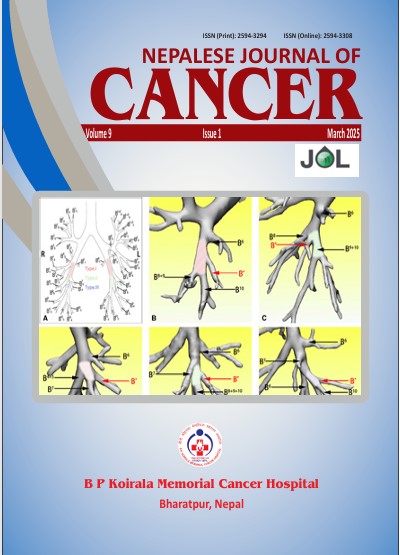Diagnostic Value of Thoracoscopic Biopsy in Undiagnosed Pleural Effusion: An outcome based retrospective study in a tertiary cancer centre
DOI:
https://doi.org/10.3126/njc.v9i1.77211Keywords:
Pleural effusion, Thoracoscope, Undiagnosed pleural effusion, VATS biopsy, pleural disease diagnosisAbstract
Background: Pleural biopsy can be performed via needle, thoracoscopy, or open surgery, with thoracoscopic biopsy emerging as a valuable tool for diagnosing pleural diseases. Video-assisted thoracoscopic surgery (VATS) offers direct visual assessment and targeted tissue sampling, with a diagnostic yield comparable to open biopsy while remaining minimally invasive. Despite extensive diagnostic efforts, the etiology of pleural effusion remains unclear in 20–25% of cases, necessitating more definitive diagnostic approaches.
Objectives: This study aims to evaluate the diagnostic yield, accuracy, and clinical outcomes of thoracoscopic biopsy in patients with undiagnosed pleural effusion.
Methods: Our study included patients who had undergone Video assisted thoracoscope biopsy (VATS) for undiagnosed pleural effusion at our center since 2015 to 2024. There was no follow up in our study. Data from 149 patients were taken and entered in Excel and analyzed via Statistical package for the social sciences (SPSS 27).
Results: A total of 149 patients were included. The overall diagnostic yield of thoracoscopic biopsy was 98%, with malignancy being the most common diagnosis i.e.,75.3%. The procedure was well tolerated, with a complication seen in just 5 patients(3.36%) and no in-hospital mortality.
Conclusion: Thoracoscopic biopsy is safe, highly effective diagnostic modality for undiagnosed pleural effusion. It has an advantage of having high accuracy and being minimally invasive. Thoracoscopic biopsy influence clinical management, leading to targeted treatment strategies.
Downloads
Downloads
Published
How to Cite
Issue
Section
License
Copyright (c) 2025 Nepalese Journal of Cancer

This work is licensed under a Creative Commons Attribution 4.0 International License.
This license lets others distribute, remix, tweak, and build upon your work, even commercially, as long as NJC and the authors are acknowledged.
Submission of the manuscript means that the authors agree to assign exclusive copyright to NJC. The aim of NJC is to increase the visibility and ease of use of open access scientific and scholarly articles thereby promoting their increased usage and impact.




